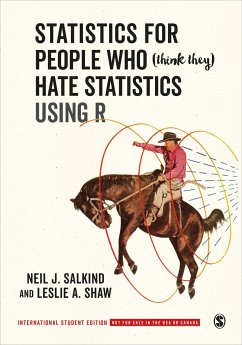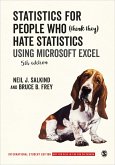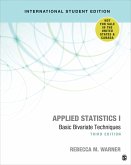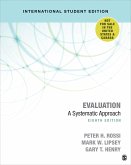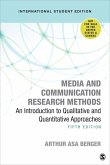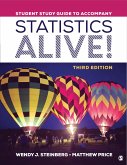Neil J. Salkind, Leslie A. Shaw
Statistics for People Who (Think They) Hate Statistics Using R - International Student Edition
Neil J. Salkind, Leslie A. Shaw
Statistics for People Who (Think They) Hate Statistics Using R - International Student Edition
- Broschiertes Buch
- Merkliste
- Auf die Merkliste
- Bewerten Bewerten
- Teilen
- Produkt teilen
- Produkterinnerung
- Produkterinnerung
Statistics for People Who (Think They) Hate Statistics Using RÂ with new co-author Leslie A. Shaw carries forward Neil J. Salkindâ s signature humorous, personable, and informative approach, providing a grounding in statistical basics, R computing and the application of statistics to research studies.
Andere Kunden interessierten sich auch für
![Statistics for People Who (Think They) Hate Statistics - International Student Edition Statistics for People Who (Think They) Hate Statistics - International Student Edition]() Neil J. SalkindStatistics for People Who (Think They) Hate Statistics - International Student Edition153,99 €
Neil J. SalkindStatistics for People Who (Think They) Hate Statistics - International Student Edition153,99 €![Applied Statistics I - International Student Edition Applied Statistics I - International Student Edition]() Rebecca M. WarnerApplied Statistics I - International Student Edition178,99 €
Rebecca M. WarnerApplied Statistics I - International Student Edition178,99 €![Evaluation - International Student Edition Evaluation - International Student Edition]() Peter H. RossiEvaluation - International Student Edition153,99 €
Peter H. RossiEvaluation - International Student Edition153,99 €![Media and Communication Research Methods - International Student Edition Media and Communication Research Methods - International Student Edition]() Berger, Arthur A,Media and Communication Research Methods - International Student Edition153,99 €
Berger, Arthur A,Media and Communication Research Methods - International Student Edition153,99 €![Student Study Guide to Accompany Statistics Alive! Student Study Guide to Accompany Statistics Alive!]() Wendy J. SteinbergStudent Study Guide to Accompany Statistics Alive!89,99 €
Wendy J. SteinbergStudent Study Guide to Accompany Statistics Alive!89,99 €![The Middle East - International Student Edition The Middle East - International Student Edition]() The Middle East - International Student Edition178,99 €
The Middle East - International Student Edition178,99 €![International Politics - International Student Edition International Politics - International Student Edition]() International Politics - International Student Edition164,99 €
International Politics - International Student Edition164,99 €-
-
-
Statistics for People Who (Think They) Hate Statistics Using RÂ with new co-author Leslie A. Shaw carries forward Neil J. Salkindâ s signature humorous, personable, and informative approach, providing a grounding in statistical basics, R computing and the application of statistics to research studies.
Produktdetails
- Produktdetails
- Verlag: SAGE Publications Inc
- Erscheinungstermin: 12. September 2019
- Englisch
- Abmessung: 178mm x 254mm x 29mm
- Gewicht: 988g
- ISBN-13: 9781544387888
- ISBN-10: 1544387881
- Artikelnr.: 57802715
- Herstellerkennzeichnung
- Libri GmbH
- Europaallee 1
- 36244 Bad Hersfeld
- gpsr@libri.de
- Verlag: SAGE Publications Inc
- Erscheinungstermin: 12. September 2019
- Englisch
- Abmessung: 178mm x 254mm x 29mm
- Gewicht: 988g
- ISBN-13: 9781544387888
- ISBN-10: 1544387881
- Artikelnr.: 57802715
- Herstellerkennzeichnung
- Libri GmbH
- Europaallee 1
- 36244 Bad Hersfeld
- gpsr@libri.de
Neil J. Salkind received his PhD in human development from the University of Maryland, and after teaching for 35 years at the University of Kansas, he was Professor Emeritus in the Department of Psychology and Research in Education, where he collaborated with colleagues and work with students. His early interests were in the area of children's cognitive development, and after research in the areas of cognitive style and (what was then known as) hyperactivity, he was a postdoctoral fellow at the University of North Carolina's Bush Center for Child and Family Policy. His work then changed direction to focus on child and family policy, specifically the impact of alternative forms of public support on various child and family outcomes. He delivered more than 150 professional papers and presentations; written more than 100 trade and textbooks; and is the author of Statistics for People Who (Think They) Hate Statistics (SAGE), Theories of Human Development (SAGE), and Exploring Research (Prentice Hall). He has edited several encyclopedias, including the Encyclopedia of Human Development, the Encyclopedia of Measurement and Statistics, and the Encyclopedia of Research Design. He was editor of Child Development Abstracts and Bibliography for 13 years. He lived in Lawrence, Kansas, where he liked to read, swim with the River City Sharks, work as the proprietor and sole employee of big boy press, bake brownies (see www.statisticsforpeople.com for the recipe), and poke around old Volvos and old houses.
Preface
Acknowledgements
About the Authors
Part I Yippee! I'm in Statistics
Chapter 1. Statistics or Sadistics? It's Up to You
What You Will Learn in This Chapter
Why Statistics?
A 5-Minute History of Statistics
Statistics: What it is and Isn't
What am I doing in a Statistics Class?
Ten Ways to Use this Book (and Learn Statistics at the Same Time)
Key to Difficulty Icons
Glossary
Real-World Stats
Summary
Time to Practice
Part II Welcome to the Interesting, Flexible, Useful, Fun and (Very) Deep
Worlds of R and RStudio
Chapter 2. Here's Why We Love R and How to Get Started
What You Will Learn in This Chapter
A Very Short History of R
The Plusses of Using R
Where to Find and Download R
The Opening R Screen
A Note About Formatting
Bunches of Data - Free!
Getting R Help
Some Important Lingo
RStudio
Where to Find RStudio and How to Install It
Ordering from RStudio
Summary
Time to Practice
Chapter 3. Using RStudio: Much Easier Than You Think
What You Will Learn in This Chapter
Why RStudio (and Why Not Just R?)
The Grand Tour and All About Those Four Panes
RStudio Pane Goodies
Showing Your Stuff - Working With Menus and Tabs and A Sample Data Analysis
Using RStudio
Working with Data
Next Step: Using and Importing Datasets
Reading in Established Datasets
Computing Some Statistics
Summary
Time to Practice
Part III Sigma Freud and Descriptive Statistics
Chapter 4. Means to an End: Computing and Understanding Averages
What You Will Learn in This Chapter
What You Will Learn in This Chapter Computing the Mean
Computing the Median
Computing the Mode
When to Use What Measure of Central Tendency (and All You Need to Know
About Scales of Measurement for Now)
Using the Computer to Compute Descriptive Statistics
Real World Stats
Summary
Time to Practice
Chapter 5. Understanding Variability: Vive la Différence
What You Will Learn in This Chapter
Why Understanding Variability is Important
Computing the Range
Computing the Standard Deviation
Computing the Variance
Using R to Compute Measures of Variability
Real World Stats
Summary
Time to Practice
Chapter 6. Creating Graphs: A Picture Really Is Worth a Thousand Words
What You Will Learn in This Chapter
Why Illustrate Data?
Ten Ways to a Great Graphic
First Things First: Creating a Frequency Distribution
The Plot Thickens: Creating a Histogram
The Next Step: A Frequency Polygon
Other Cool Ways to Chart Data
Using the Computer (R, That Is) to Illustrate Data
Real World Stats
Summary
Time to Practice
Chapter 7. Computing Correlation Coefficients: Ice Cream and Crime
What You Will Learn in This Chapter
What are Correlations All About?
Computing a Simple Correlation Coefficient
Understanding What the Correlation Coefficient Means
A Determined Effort: Squaring the Correlation Coefficient
Other Cool Correlations
Parting Ways: A Bit About Partial Correlations
Summary
Time to Practice
Chapter 8: Understanding Reliability and Validity: Just the Truth
What You Will Learn in This Chapter
An Introduction to Reliability and Validity
Reliability: Doing it Again Until You Get it Right
Different Types of Reliability
How Big is Big? Finally: Interpreting Reliability Coefficients
Validity: Whoa! What is the Truth?
A Last Friendly Word
Validity and Reliability: Really Close Cousins
Real World Stats
Summary
Time to Practice
Part IV Taking Chances for Fun and Profit
Chapter 9. Hypotheticals and You: Testing Your Questions
What You Will Learn in This Chapter
So You Want to Be a Scientist
Samples and Populations
The Null Hypothesis
The Research Hypothesis
What Makes a Good Hypothesis?
Real-World Stats
Summary
Time to Practice
Chapter 10. Probability and Why It Counts: Fun with a Bell-Shaped Curve
What You'll Learn About in this Chapter
Why Probability?
The Normal Curve (A.K.A The Bell-Shaped Curve)
Our Favorite Standard Score
Fat and Skinny Frequency Distributions
Real World Stats
Summary
Time to Practice
Part IV Significantly Different: Using Inferential Statistics
Chapter 11. Significantly Significant: What It Means for You and Me
What You'll Learn About in this Chapter
The Concept of Significance
Significance Versus Meaningfulness
An Introduction to Inferential Statistics
An Introduction to Tests of Significance
Be Even More Confident
Real World Stats
Summary
Time to Practice
12. The One-Sample Z-Test: Only the Lonely
What You'll Learn About in this Chapter
Introduction to the One-Sample Z-Test
The Path to Wisdom and Knowledge
Computing the Z-Test Statistic
Using R to Perform a Z-Test
Special Effects: Are Those Differences for Real?
Real World Stats
Summary
Time to Practice
Chapter 13. t(ea) for Two: Tests Between the Means of Different Groups
What You'll Learn About in This Chapter
Introduction to the t-test for Independent Samples
The Path to Wisdom and Knowledge
Computing the t-Test Statistic
Using R to Perform a t-Test
Real-World Stats
Summary
Time to Practice
14. t(ea) for Two (Again): Tests Between the Means of Related Groups
What You'll Learn About in This Chapter
Introduction of the t-Test for Dependent Samples
The Path to Wisdom and Knowledge
Computing the t-Test Statistic
Using R to Perform a t-Test
The Effect Size for t(ea) for Two (Again)
Real World Stats
Summary
Time to Practice
Chapter 15. Two Groups Too Many? Try Analysis of Variance
Introduction to Analysis of Variance
The Path to Wisdom and Knowledge
Different Flavors of ANOVA
Computing the F-test Statistic
Using R to Compute the F Ratio
The Effect Size for One-Way ANOVA
But Where is the Difference?
Real World Stats
Summary
Time to Practice
Chapter 16. Two Too Many Factors: Factorial Analysis of Variance-A Brief
Introduction
What You'll Learn About in This Chapter
Introduction to Factorial Analysis of Variance
The Path to Wisdom and Knowledge
A New Flavor of ANOVA
All of These Effects
Even More Interesting Interaction Effects
Using R to Compute the F Ratio
Computing the Effect Size for Factorial ANOVA
Real World Stats
Summary
Time to Practice
Chapter 17. Testing Relationships Using the Correlation Coefficient:
Cousins or Just Good Friends?
What You'll Learn About in This Chapter
Introduction to Testing the Correlation Coefficient
The Path to Wisdom and Knowledge
Computing the Test Statistic
Using R to Compute a Correlation Coefficient (Again)
Real World Stats
Summary
Time to Practice
18. Using Linear Regression: Predicting the Future
What You'll Learn About in this Chapter
Introduction to Linear Regression
What is Prediction All About?
The Logic of Prediction
Drawing the World's Best Line (for Your Data)
How Good is Your Prediction?
Using R to Compute the Regression Line
The More Predictors the Better? Maybe
Real World Stats
Summary
Time to Practice
Part VI More Statistics! More Tools! More Fun!
Chapter 19. Chi-Square and Some Other Nonparametric Tests: What to Do When
You're Not Normal
What You'll Learn About in this Chapter
Introduction toe Nonparametric Statistics
Introduction to the Goodness of Fit (One-Sample) Chi-Square
Computing the Goodness of Fit Chi-Square Test Statistic
Introduction to the Test of Independence Chi-Square
Computing the Test of Independence Chi-Square Test Statistic
Using R to Perform Chi-Square Tests
Summary
Time to Practice
20. Some Other (Important) Statistical Procedures You Should Know About: A
Statistical Software Sampler
What You'll Learn About in this Chapter
Multivariate Analysis of Variance
Repeated Measures Analysis of Variance
Analysis of Covariance
Multiple Regression
Multilevel Models
Meta-Analysis
Logistic Regression
Factor Analysis
Path Analysis
Structural Equation Modeling
Summary
Appendix A: More Fun Stuff with R and RStudio
Appendix B: Tables
Appendix C: Data Sets
Appendix D: Answers to Practice Questions
Appendix E: Math: Just the Basics
Appendix F: The Ten (or More) Best (and Most Fun) Internet Sites for
Statistics Stuff
Appendix G: The Ten Commandments of Data Collection
Appendix H: Glossary
Appendix I: The Reward
Index
Acknowledgements
About the Authors
Part I Yippee! I'm in Statistics
Chapter 1. Statistics or Sadistics? It's Up to You
What You Will Learn in This Chapter
Why Statistics?
A 5-Minute History of Statistics
Statistics: What it is and Isn't
What am I doing in a Statistics Class?
Ten Ways to Use this Book (and Learn Statistics at the Same Time)
Key to Difficulty Icons
Glossary
Real-World Stats
Summary
Time to Practice
Part II Welcome to the Interesting, Flexible, Useful, Fun and (Very) Deep
Worlds of R and RStudio
Chapter 2. Here's Why We Love R and How to Get Started
What You Will Learn in This Chapter
A Very Short History of R
The Plusses of Using R
Where to Find and Download R
The Opening R Screen
A Note About Formatting
Bunches of Data - Free!
Getting R Help
Some Important Lingo
RStudio
Where to Find RStudio and How to Install It
Ordering from RStudio
Summary
Time to Practice
Chapter 3. Using RStudio: Much Easier Than You Think
What You Will Learn in This Chapter
Why RStudio (and Why Not Just R?)
The Grand Tour and All About Those Four Panes
RStudio Pane Goodies
Showing Your Stuff - Working With Menus and Tabs and A Sample Data Analysis
Using RStudio
Working with Data
Next Step: Using and Importing Datasets
Reading in Established Datasets
Computing Some Statistics
Summary
Time to Practice
Part III Sigma Freud and Descriptive Statistics
Chapter 4. Means to an End: Computing and Understanding Averages
What You Will Learn in This Chapter
What You Will Learn in This Chapter Computing the Mean
Computing the Median
Computing the Mode
When to Use What Measure of Central Tendency (and All You Need to Know
About Scales of Measurement for Now)
Using the Computer to Compute Descriptive Statistics
Real World Stats
Summary
Time to Practice
Chapter 5. Understanding Variability: Vive la Différence
What You Will Learn in This Chapter
Why Understanding Variability is Important
Computing the Range
Computing the Standard Deviation
Computing the Variance
Using R to Compute Measures of Variability
Real World Stats
Summary
Time to Practice
Chapter 6. Creating Graphs: A Picture Really Is Worth a Thousand Words
What You Will Learn in This Chapter
Why Illustrate Data?
Ten Ways to a Great Graphic
First Things First: Creating a Frequency Distribution
The Plot Thickens: Creating a Histogram
The Next Step: A Frequency Polygon
Other Cool Ways to Chart Data
Using the Computer (R, That Is) to Illustrate Data
Real World Stats
Summary
Time to Practice
Chapter 7. Computing Correlation Coefficients: Ice Cream and Crime
What You Will Learn in This Chapter
What are Correlations All About?
Computing a Simple Correlation Coefficient
Understanding What the Correlation Coefficient Means
A Determined Effort: Squaring the Correlation Coefficient
Other Cool Correlations
Parting Ways: A Bit About Partial Correlations
Summary
Time to Practice
Chapter 8: Understanding Reliability and Validity: Just the Truth
What You Will Learn in This Chapter
An Introduction to Reliability and Validity
Reliability: Doing it Again Until You Get it Right
Different Types of Reliability
How Big is Big? Finally: Interpreting Reliability Coefficients
Validity: Whoa! What is the Truth?
A Last Friendly Word
Validity and Reliability: Really Close Cousins
Real World Stats
Summary
Time to Practice
Part IV Taking Chances for Fun and Profit
Chapter 9. Hypotheticals and You: Testing Your Questions
What You Will Learn in This Chapter
So You Want to Be a Scientist
Samples and Populations
The Null Hypothesis
The Research Hypothesis
What Makes a Good Hypothesis?
Real-World Stats
Summary
Time to Practice
Chapter 10. Probability and Why It Counts: Fun with a Bell-Shaped Curve
What You'll Learn About in this Chapter
Why Probability?
The Normal Curve (A.K.A The Bell-Shaped Curve)
Our Favorite Standard Score
Fat and Skinny Frequency Distributions
Real World Stats
Summary
Time to Practice
Part IV Significantly Different: Using Inferential Statistics
Chapter 11. Significantly Significant: What It Means for You and Me
What You'll Learn About in this Chapter
The Concept of Significance
Significance Versus Meaningfulness
An Introduction to Inferential Statistics
An Introduction to Tests of Significance
Be Even More Confident
Real World Stats
Summary
Time to Practice
12. The One-Sample Z-Test: Only the Lonely
What You'll Learn About in this Chapter
Introduction to the One-Sample Z-Test
The Path to Wisdom and Knowledge
Computing the Z-Test Statistic
Using R to Perform a Z-Test
Special Effects: Are Those Differences for Real?
Real World Stats
Summary
Time to Practice
Chapter 13. t(ea) for Two: Tests Between the Means of Different Groups
What You'll Learn About in This Chapter
Introduction to the t-test for Independent Samples
The Path to Wisdom and Knowledge
Computing the t-Test Statistic
Using R to Perform a t-Test
Real-World Stats
Summary
Time to Practice
14. t(ea) for Two (Again): Tests Between the Means of Related Groups
What You'll Learn About in This Chapter
Introduction of the t-Test for Dependent Samples
The Path to Wisdom and Knowledge
Computing the t-Test Statistic
Using R to Perform a t-Test
The Effect Size for t(ea) for Two (Again)
Real World Stats
Summary
Time to Practice
Chapter 15. Two Groups Too Many? Try Analysis of Variance
Introduction to Analysis of Variance
The Path to Wisdom and Knowledge
Different Flavors of ANOVA
Computing the F-test Statistic
Using R to Compute the F Ratio
The Effect Size for One-Way ANOVA
But Where is the Difference?
Real World Stats
Summary
Time to Practice
Chapter 16. Two Too Many Factors: Factorial Analysis of Variance-A Brief
Introduction
What You'll Learn About in This Chapter
Introduction to Factorial Analysis of Variance
The Path to Wisdom and Knowledge
A New Flavor of ANOVA
All of These Effects
Even More Interesting Interaction Effects
Using R to Compute the F Ratio
Computing the Effect Size for Factorial ANOVA
Real World Stats
Summary
Time to Practice
Chapter 17. Testing Relationships Using the Correlation Coefficient:
Cousins or Just Good Friends?
What You'll Learn About in This Chapter
Introduction to Testing the Correlation Coefficient
The Path to Wisdom and Knowledge
Computing the Test Statistic
Using R to Compute a Correlation Coefficient (Again)
Real World Stats
Summary
Time to Practice
18. Using Linear Regression: Predicting the Future
What You'll Learn About in this Chapter
Introduction to Linear Regression
What is Prediction All About?
The Logic of Prediction
Drawing the World's Best Line (for Your Data)
How Good is Your Prediction?
Using R to Compute the Regression Line
The More Predictors the Better? Maybe
Real World Stats
Summary
Time to Practice
Part VI More Statistics! More Tools! More Fun!
Chapter 19. Chi-Square and Some Other Nonparametric Tests: What to Do When
You're Not Normal
What You'll Learn About in this Chapter
Introduction toe Nonparametric Statistics
Introduction to the Goodness of Fit (One-Sample) Chi-Square
Computing the Goodness of Fit Chi-Square Test Statistic
Introduction to the Test of Independence Chi-Square
Computing the Test of Independence Chi-Square Test Statistic
Using R to Perform Chi-Square Tests
Summary
Time to Practice
20. Some Other (Important) Statistical Procedures You Should Know About: A
Statistical Software Sampler
What You'll Learn About in this Chapter
Multivariate Analysis of Variance
Repeated Measures Analysis of Variance
Analysis of Covariance
Multiple Regression
Multilevel Models
Meta-Analysis
Logistic Regression
Factor Analysis
Path Analysis
Structural Equation Modeling
Summary
Appendix A: More Fun Stuff with R and RStudio
Appendix B: Tables
Appendix C: Data Sets
Appendix D: Answers to Practice Questions
Appendix E: Math: Just the Basics
Appendix F: The Ten (or More) Best (and Most Fun) Internet Sites for
Statistics Stuff
Appendix G: The Ten Commandments of Data Collection
Appendix H: Glossary
Appendix I: The Reward
Index
Preface
Acknowledgements
About the Authors
Part I Yippee! I'm in Statistics
Chapter 1. Statistics or Sadistics? It's Up to You
What You Will Learn in This Chapter
Why Statistics?
A 5-Minute History of Statistics
Statistics: What it is and Isn't
What am I doing in a Statistics Class?
Ten Ways to Use this Book (and Learn Statistics at the Same Time)
Key to Difficulty Icons
Glossary
Real-World Stats
Summary
Time to Practice
Part II Welcome to the Interesting, Flexible, Useful, Fun and (Very) Deep
Worlds of R and RStudio
Chapter 2. Here's Why We Love R and How to Get Started
What You Will Learn in This Chapter
A Very Short History of R
The Plusses of Using R
Where to Find and Download R
The Opening R Screen
A Note About Formatting
Bunches of Data - Free!
Getting R Help
Some Important Lingo
RStudio
Where to Find RStudio and How to Install It
Ordering from RStudio
Summary
Time to Practice
Chapter 3. Using RStudio: Much Easier Than You Think
What You Will Learn in This Chapter
Why RStudio (and Why Not Just R?)
The Grand Tour and All About Those Four Panes
RStudio Pane Goodies
Showing Your Stuff - Working With Menus and Tabs and A Sample Data Analysis
Using RStudio
Working with Data
Next Step: Using and Importing Datasets
Reading in Established Datasets
Computing Some Statistics
Summary
Time to Practice
Part III Sigma Freud and Descriptive Statistics
Chapter 4. Means to an End: Computing and Understanding Averages
What You Will Learn in This Chapter
What You Will Learn in This Chapter Computing the Mean
Computing the Median
Computing the Mode
When to Use What Measure of Central Tendency (and All You Need to Know
About Scales of Measurement for Now)
Using the Computer to Compute Descriptive Statistics
Real World Stats
Summary
Time to Practice
Chapter 5. Understanding Variability: Vive la Différence
What You Will Learn in This Chapter
Why Understanding Variability is Important
Computing the Range
Computing the Standard Deviation
Computing the Variance
Using R to Compute Measures of Variability
Real World Stats
Summary
Time to Practice
Chapter 6. Creating Graphs: A Picture Really Is Worth a Thousand Words
What You Will Learn in This Chapter
Why Illustrate Data?
Ten Ways to a Great Graphic
First Things First: Creating a Frequency Distribution
The Plot Thickens: Creating a Histogram
The Next Step: A Frequency Polygon
Other Cool Ways to Chart Data
Using the Computer (R, That Is) to Illustrate Data
Real World Stats
Summary
Time to Practice
Chapter 7. Computing Correlation Coefficients: Ice Cream and Crime
What You Will Learn in This Chapter
What are Correlations All About?
Computing a Simple Correlation Coefficient
Understanding What the Correlation Coefficient Means
A Determined Effort: Squaring the Correlation Coefficient
Other Cool Correlations
Parting Ways: A Bit About Partial Correlations
Summary
Time to Practice
Chapter 8: Understanding Reliability and Validity: Just the Truth
What You Will Learn in This Chapter
An Introduction to Reliability and Validity
Reliability: Doing it Again Until You Get it Right
Different Types of Reliability
How Big is Big? Finally: Interpreting Reliability Coefficients
Validity: Whoa! What is the Truth?
A Last Friendly Word
Validity and Reliability: Really Close Cousins
Real World Stats
Summary
Time to Practice
Part IV Taking Chances for Fun and Profit
Chapter 9. Hypotheticals and You: Testing Your Questions
What You Will Learn in This Chapter
So You Want to Be a Scientist
Samples and Populations
The Null Hypothesis
The Research Hypothesis
What Makes a Good Hypothesis?
Real-World Stats
Summary
Time to Practice
Chapter 10. Probability and Why It Counts: Fun with a Bell-Shaped Curve
What You'll Learn About in this Chapter
Why Probability?
The Normal Curve (A.K.A The Bell-Shaped Curve)
Our Favorite Standard Score
Fat and Skinny Frequency Distributions
Real World Stats
Summary
Time to Practice
Part IV Significantly Different: Using Inferential Statistics
Chapter 11. Significantly Significant: What It Means for You and Me
What You'll Learn About in this Chapter
The Concept of Significance
Significance Versus Meaningfulness
An Introduction to Inferential Statistics
An Introduction to Tests of Significance
Be Even More Confident
Real World Stats
Summary
Time to Practice
12. The One-Sample Z-Test: Only the Lonely
What You'll Learn About in this Chapter
Introduction to the One-Sample Z-Test
The Path to Wisdom and Knowledge
Computing the Z-Test Statistic
Using R to Perform a Z-Test
Special Effects: Are Those Differences for Real?
Real World Stats
Summary
Time to Practice
Chapter 13. t(ea) for Two: Tests Between the Means of Different Groups
What You'll Learn About in This Chapter
Introduction to the t-test for Independent Samples
The Path to Wisdom and Knowledge
Computing the t-Test Statistic
Using R to Perform a t-Test
Real-World Stats
Summary
Time to Practice
14. t(ea) for Two (Again): Tests Between the Means of Related Groups
What You'll Learn About in This Chapter
Introduction of the t-Test for Dependent Samples
The Path to Wisdom and Knowledge
Computing the t-Test Statistic
Using R to Perform a t-Test
The Effect Size for t(ea) for Two (Again)
Real World Stats
Summary
Time to Practice
Chapter 15. Two Groups Too Many? Try Analysis of Variance
Introduction to Analysis of Variance
The Path to Wisdom and Knowledge
Different Flavors of ANOVA
Computing the F-test Statistic
Using R to Compute the F Ratio
The Effect Size for One-Way ANOVA
But Where is the Difference?
Real World Stats
Summary
Time to Practice
Chapter 16. Two Too Many Factors: Factorial Analysis of Variance-A Brief
Introduction
What You'll Learn About in This Chapter
Introduction to Factorial Analysis of Variance
The Path to Wisdom and Knowledge
A New Flavor of ANOVA
All of These Effects
Even More Interesting Interaction Effects
Using R to Compute the F Ratio
Computing the Effect Size for Factorial ANOVA
Real World Stats
Summary
Time to Practice
Chapter 17. Testing Relationships Using the Correlation Coefficient:
Cousins or Just Good Friends?
What You'll Learn About in This Chapter
Introduction to Testing the Correlation Coefficient
The Path to Wisdom and Knowledge
Computing the Test Statistic
Using R to Compute a Correlation Coefficient (Again)
Real World Stats
Summary
Time to Practice
18. Using Linear Regression: Predicting the Future
What You'll Learn About in this Chapter
Introduction to Linear Regression
What is Prediction All About?
The Logic of Prediction
Drawing the World's Best Line (for Your Data)
How Good is Your Prediction?
Using R to Compute the Regression Line
The More Predictors the Better? Maybe
Real World Stats
Summary
Time to Practice
Part VI More Statistics! More Tools! More Fun!
Chapter 19. Chi-Square and Some Other Nonparametric Tests: What to Do When
You're Not Normal
What You'll Learn About in this Chapter
Introduction toe Nonparametric Statistics
Introduction to the Goodness of Fit (One-Sample) Chi-Square
Computing the Goodness of Fit Chi-Square Test Statistic
Introduction to the Test of Independence Chi-Square
Computing the Test of Independence Chi-Square Test Statistic
Using R to Perform Chi-Square Tests
Summary
Time to Practice
20. Some Other (Important) Statistical Procedures You Should Know About: A
Statistical Software Sampler
What You'll Learn About in this Chapter
Multivariate Analysis of Variance
Repeated Measures Analysis of Variance
Analysis of Covariance
Multiple Regression
Multilevel Models
Meta-Analysis
Logistic Regression
Factor Analysis
Path Analysis
Structural Equation Modeling
Summary
Appendix A: More Fun Stuff with R and RStudio
Appendix B: Tables
Appendix C: Data Sets
Appendix D: Answers to Practice Questions
Appendix E: Math: Just the Basics
Appendix F: The Ten (or More) Best (and Most Fun) Internet Sites for
Statistics Stuff
Appendix G: The Ten Commandments of Data Collection
Appendix H: Glossary
Appendix I: The Reward
Index
Acknowledgements
About the Authors
Part I Yippee! I'm in Statistics
Chapter 1. Statistics or Sadistics? It's Up to You
What You Will Learn in This Chapter
Why Statistics?
A 5-Minute History of Statistics
Statistics: What it is and Isn't
What am I doing in a Statistics Class?
Ten Ways to Use this Book (and Learn Statistics at the Same Time)
Key to Difficulty Icons
Glossary
Real-World Stats
Summary
Time to Practice
Part II Welcome to the Interesting, Flexible, Useful, Fun and (Very) Deep
Worlds of R and RStudio
Chapter 2. Here's Why We Love R and How to Get Started
What You Will Learn in This Chapter
A Very Short History of R
The Plusses of Using R
Where to Find and Download R
The Opening R Screen
A Note About Formatting
Bunches of Data - Free!
Getting R Help
Some Important Lingo
RStudio
Where to Find RStudio and How to Install It
Ordering from RStudio
Summary
Time to Practice
Chapter 3. Using RStudio: Much Easier Than You Think
What You Will Learn in This Chapter
Why RStudio (and Why Not Just R?)
The Grand Tour and All About Those Four Panes
RStudio Pane Goodies
Showing Your Stuff - Working With Menus and Tabs and A Sample Data Analysis
Using RStudio
Working with Data
Next Step: Using and Importing Datasets
Reading in Established Datasets
Computing Some Statistics
Summary
Time to Practice
Part III Sigma Freud and Descriptive Statistics
Chapter 4. Means to an End: Computing and Understanding Averages
What You Will Learn in This Chapter
What You Will Learn in This Chapter Computing the Mean
Computing the Median
Computing the Mode
When to Use What Measure of Central Tendency (and All You Need to Know
About Scales of Measurement for Now)
Using the Computer to Compute Descriptive Statistics
Real World Stats
Summary
Time to Practice
Chapter 5. Understanding Variability: Vive la Différence
What You Will Learn in This Chapter
Why Understanding Variability is Important
Computing the Range
Computing the Standard Deviation
Computing the Variance
Using R to Compute Measures of Variability
Real World Stats
Summary
Time to Practice
Chapter 6. Creating Graphs: A Picture Really Is Worth a Thousand Words
What You Will Learn in This Chapter
Why Illustrate Data?
Ten Ways to a Great Graphic
First Things First: Creating a Frequency Distribution
The Plot Thickens: Creating a Histogram
The Next Step: A Frequency Polygon
Other Cool Ways to Chart Data
Using the Computer (R, That Is) to Illustrate Data
Real World Stats
Summary
Time to Practice
Chapter 7. Computing Correlation Coefficients: Ice Cream and Crime
What You Will Learn in This Chapter
What are Correlations All About?
Computing a Simple Correlation Coefficient
Understanding What the Correlation Coefficient Means
A Determined Effort: Squaring the Correlation Coefficient
Other Cool Correlations
Parting Ways: A Bit About Partial Correlations
Summary
Time to Practice
Chapter 8: Understanding Reliability and Validity: Just the Truth
What You Will Learn in This Chapter
An Introduction to Reliability and Validity
Reliability: Doing it Again Until You Get it Right
Different Types of Reliability
How Big is Big? Finally: Interpreting Reliability Coefficients
Validity: Whoa! What is the Truth?
A Last Friendly Word
Validity and Reliability: Really Close Cousins
Real World Stats
Summary
Time to Practice
Part IV Taking Chances for Fun and Profit
Chapter 9. Hypotheticals and You: Testing Your Questions
What You Will Learn in This Chapter
So You Want to Be a Scientist
Samples and Populations
The Null Hypothesis
The Research Hypothesis
What Makes a Good Hypothesis?
Real-World Stats
Summary
Time to Practice
Chapter 10. Probability and Why It Counts: Fun with a Bell-Shaped Curve
What You'll Learn About in this Chapter
Why Probability?
The Normal Curve (A.K.A The Bell-Shaped Curve)
Our Favorite Standard Score
Fat and Skinny Frequency Distributions
Real World Stats
Summary
Time to Practice
Part IV Significantly Different: Using Inferential Statistics
Chapter 11. Significantly Significant: What It Means for You and Me
What You'll Learn About in this Chapter
The Concept of Significance
Significance Versus Meaningfulness
An Introduction to Inferential Statistics
An Introduction to Tests of Significance
Be Even More Confident
Real World Stats
Summary
Time to Practice
12. The One-Sample Z-Test: Only the Lonely
What You'll Learn About in this Chapter
Introduction to the One-Sample Z-Test
The Path to Wisdom and Knowledge
Computing the Z-Test Statistic
Using R to Perform a Z-Test
Special Effects: Are Those Differences for Real?
Real World Stats
Summary
Time to Practice
Chapter 13. t(ea) for Two: Tests Between the Means of Different Groups
What You'll Learn About in This Chapter
Introduction to the t-test for Independent Samples
The Path to Wisdom and Knowledge
Computing the t-Test Statistic
Using R to Perform a t-Test
Real-World Stats
Summary
Time to Practice
14. t(ea) for Two (Again): Tests Between the Means of Related Groups
What You'll Learn About in This Chapter
Introduction of the t-Test for Dependent Samples
The Path to Wisdom and Knowledge
Computing the t-Test Statistic
Using R to Perform a t-Test
The Effect Size for t(ea) for Two (Again)
Real World Stats
Summary
Time to Practice
Chapter 15. Two Groups Too Many? Try Analysis of Variance
Introduction to Analysis of Variance
The Path to Wisdom and Knowledge
Different Flavors of ANOVA
Computing the F-test Statistic
Using R to Compute the F Ratio
The Effect Size for One-Way ANOVA
But Where is the Difference?
Real World Stats
Summary
Time to Practice
Chapter 16. Two Too Many Factors: Factorial Analysis of Variance-A Brief
Introduction
What You'll Learn About in This Chapter
Introduction to Factorial Analysis of Variance
The Path to Wisdom and Knowledge
A New Flavor of ANOVA
All of These Effects
Even More Interesting Interaction Effects
Using R to Compute the F Ratio
Computing the Effect Size for Factorial ANOVA
Real World Stats
Summary
Time to Practice
Chapter 17. Testing Relationships Using the Correlation Coefficient:
Cousins or Just Good Friends?
What You'll Learn About in This Chapter
Introduction to Testing the Correlation Coefficient
The Path to Wisdom and Knowledge
Computing the Test Statistic
Using R to Compute a Correlation Coefficient (Again)
Real World Stats
Summary
Time to Practice
18. Using Linear Regression: Predicting the Future
What You'll Learn About in this Chapter
Introduction to Linear Regression
What is Prediction All About?
The Logic of Prediction
Drawing the World's Best Line (for Your Data)
How Good is Your Prediction?
Using R to Compute the Regression Line
The More Predictors the Better? Maybe
Real World Stats
Summary
Time to Practice
Part VI More Statistics! More Tools! More Fun!
Chapter 19. Chi-Square and Some Other Nonparametric Tests: What to Do When
You're Not Normal
What You'll Learn About in this Chapter
Introduction toe Nonparametric Statistics
Introduction to the Goodness of Fit (One-Sample) Chi-Square
Computing the Goodness of Fit Chi-Square Test Statistic
Introduction to the Test of Independence Chi-Square
Computing the Test of Independence Chi-Square Test Statistic
Using R to Perform Chi-Square Tests
Summary
Time to Practice
20. Some Other (Important) Statistical Procedures You Should Know About: A
Statistical Software Sampler
What You'll Learn About in this Chapter
Multivariate Analysis of Variance
Repeated Measures Analysis of Variance
Analysis of Covariance
Multiple Regression
Multilevel Models
Meta-Analysis
Logistic Regression
Factor Analysis
Path Analysis
Structural Equation Modeling
Summary
Appendix A: More Fun Stuff with R and RStudio
Appendix B: Tables
Appendix C: Data Sets
Appendix D: Answers to Practice Questions
Appendix E: Math: Just the Basics
Appendix F: The Ten (or More) Best (and Most Fun) Internet Sites for
Statistics Stuff
Appendix G: The Ten Commandments of Data Collection
Appendix H: Glossary
Appendix I: The Reward
Index

